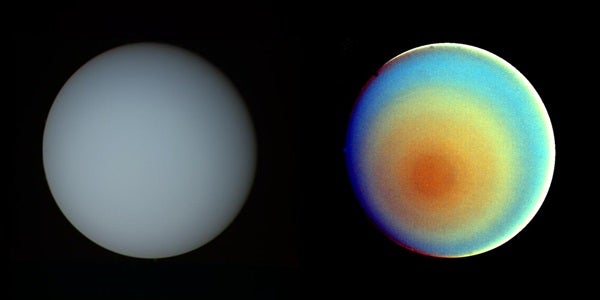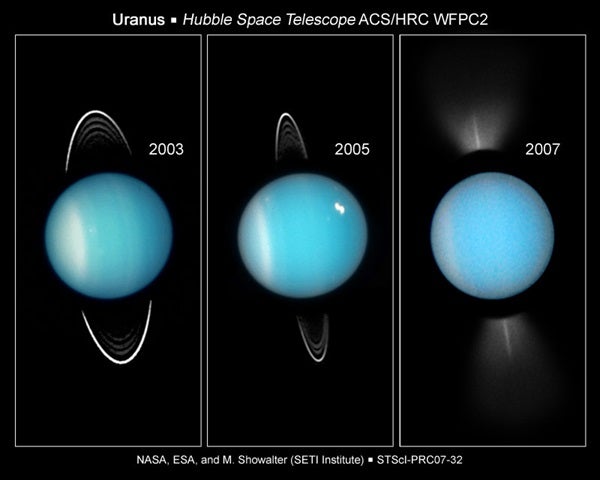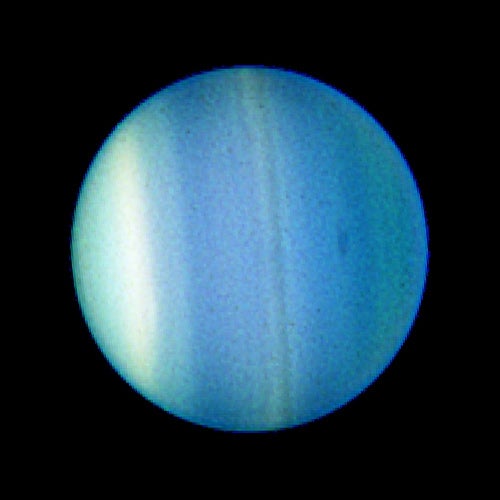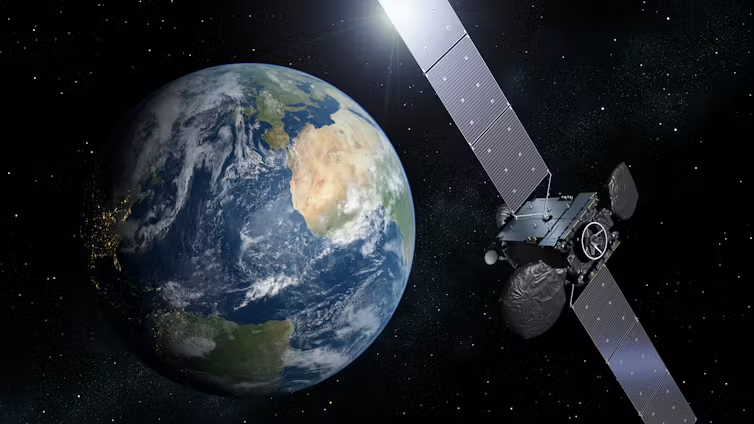Transcript
The seventh planet from the Sun, Uranus is named after the Greek god of the sky. British astronomer William Herschel discovered it with the aid of a telescope March 13, 1781. Uranus is the third-largest planet in diameter in our solar system (with Jupiter and Saturn being larger planets). Much of the seventh planet is composed of hydrogen, helium, methane, ammonia, and water. Uranus’ blue-green color is actually a result of the planet’s methane, which absorbs red wavelengths and reflects blue. The planet likely has a small rocky core.
Uranus is roughly 31,520 miles (50,720 kilometers) wide, which is about 3.98 times the width of Earth. It also contains about 14.5 times our planet’s mass. Uranus’ orbit takes it within about 18.64 times the Earth-Sun distance at closest approach. Its farthest point is at roughly 19.75 times the Earth-Sun distance, and it takes 84.01 Earth years to complete this orbit. Uranus’ day is shorter than ours, at 17.24 Earth hours, which corresponds to 71.8 percent of Earth’s day.
Uranus does have a ring system, although it’s not nearly as brilliant as Saturn’s. Earthbound observers see the rings edge-on every 42 years due to changing seasons. Just like Earth reaches an equinox twice each year, when the Sun shines directly over the equator, Uranus’ equator lines up with the Sun (and Earth) twice during each of its 84-year orbits. Scientists with the Hubble Space Telescope snapped images of the system showing how the tilt changes over time. And recently, they’ve discovered fainter rings farther out from the planet.
Planetary scientists have discovered 27 satellites orbiting the ice giant, and have named them all after characters in works by William Shakespeare and Alexander Pope. The five largest, listed in order, are Titania, Oberon, Umbriel, Ariel, and Miranda.
In the past 10 to 15 years, astronomers have also been able to learn more about Uranus’ atmosphere, such as its cloud formation and wind movements. The bright orange spots in this near-infrared image are clouds that whip around the planet at roughly 300 mph (500 km/hr). The different color bands correspond to altitude: green and blue regions show where the atmosphere is clear and sunlight can penetrate deep into Uranus; yellow and gray regions indicate where sunlight reflects off a haze or cloud layer; and orange and red colors indicate much higher clouds.
Astronomers have even spotted a dark cloud in Uranus’ atmosphere, which typically indicates extreme winds. The splotch on the right half of the planet measures 1,100 miles by 1,900 miles (1,700 km by 3,000 km).
After the Voyager 2 flyby of Uranus in 1986, scientists called it the most boring planet. But new studies are clearly showing that Uranus has an active atmosphere, which makes this planet anything but dull. I hope this overview taught you a bit more about the seventh planet from the Sun.
We’ll continue our tour of the solar system in upcoming videos, and make sure you check out issues of Astronomy magazine, which often include news and articles about solar system objects.












